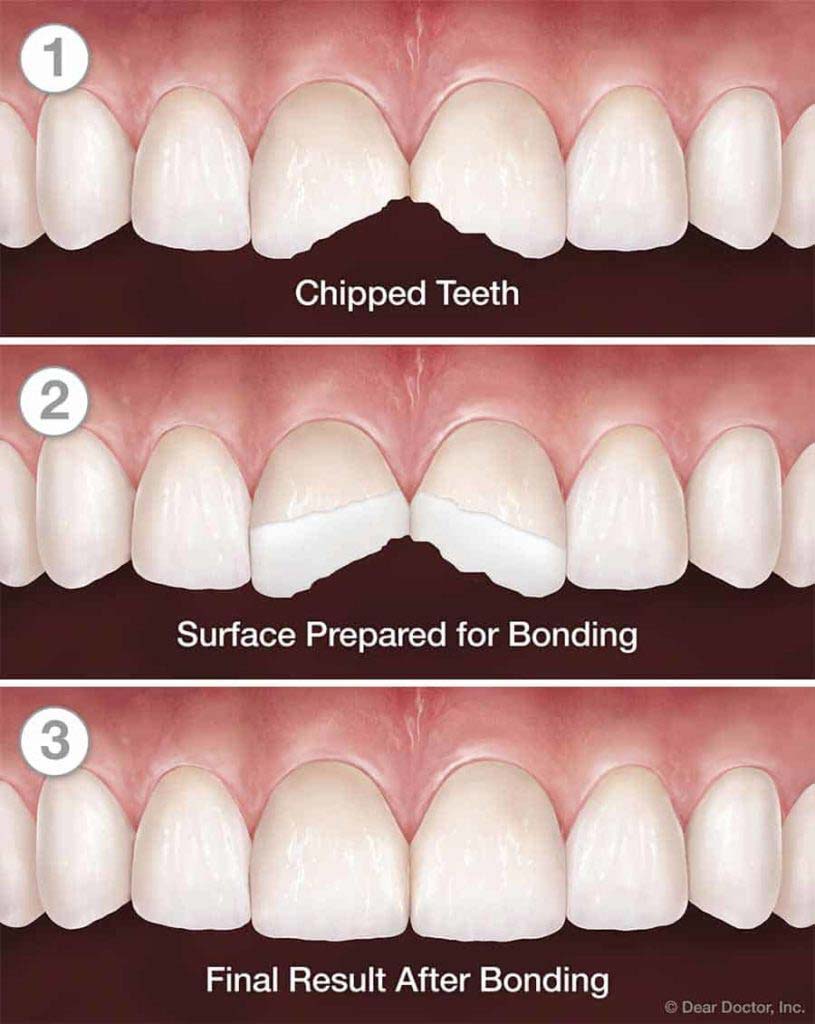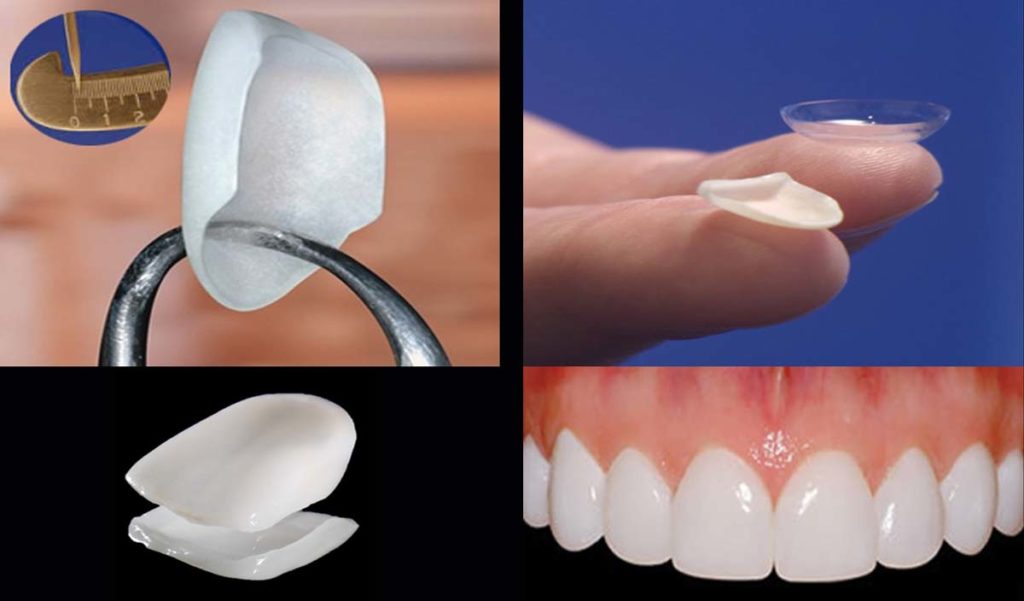Would you like to improve your smile by fixing a distracting chip or gap between your teeth, or to brighten up discolored, stained or worn-down teeth? If so, two common minimally invasive procedures that can help you achieve this are bonding and veneers. Which one is right for you? First, let’s look at what each option is.
Veneers are thin shells of porcelain, fabricated in a lab, that are layered over the front of your tooth and adhesively bonded into place. The advantage of doing porcelain veneers is that the material is much stronger, more durable, and more stain-resistant compared to resin bonding. However, despite being strong, they may still chip or break if stressed with a lot of force.
Let’s look at both in a little more detail.
Dental Bonding/When Is It Best?
Dental bonding is a cosmetic dental procedure that repairs a chipped, cracked, or otherwise broken tooth. It also helps with stained or discolored teeth, gaps between the teeth, and even lengthening a tooth that’s misshaped or shorter than the rest. It is best for teeth that have suffered only minor injuries and aren’t severely decayed. Bonding is also better suited for very small chips or restorations, because there’s less drilling and less enamel removal involved.
Typically, cosmetic bonding doesn’t require anesthesia unless you also have tooth decay that needs to be addressed, or if we need to dramatically change the shape of your tooth. You might also get anesthesia if you chipped the tooth, as the chip may have reached the sensitive dentin layer.
Additionally, tooth bonding is best for people who are already happy with the color of their teeth. If you have always wanted to whiten your teeth, you should do that before having the bonding done. When the procedure is done, your dentist will choose a composite/bonding shade that most closely matches the color of your natural teeth, and if you whiten your teeth after having bonding done, your natural enamel will get lighter, but your composite/bonding won’t change color.
What’s Involved In Teeth Bonding?
First, the dentist prepares the tooth by creating a rough surface and applying a bonding agent. The roughening procedure increases the surface area for the bond to form. Then, composite resin is added, shaped and then cured in place using a special blue light. The final shape is then fine-tuned and polished to a beautiful shine so it blends in with the enamel. The result is a seamless transition that looks just like a real tooth!
What Are The Risks Involved?
Dental bonding is a safe and relatively simple procedure. It does require some artistic skill in aesthetic cases. There are no adverse risks involved in carrying out the procedure itself. However, it is important to be aware that over time, the composite material may slowly stain, especially if you eat and drink things known to stain teeth (coffee, red wine, blueberries, turmeric, tea, etc.). The chemicals in cigarette smoke may also stain and darken your bonded fillings. Any such color changes are irreversible. Over a long period of time, they might need to be redone if they color changes too drastically.
The other main complication from dental bonding is due to the inherent weakness of the material. Composite resins are not as strong as teeth or porcelain veneers. You will need to take good care of them and always be careful when biting directly on teeth with bonded fillings. Avoid doing things like chewing on ice cubes, pens, fingernails, hard candy, and hard foods. Habits like clenching or grinding may also increase the risk of chips forming. If you or your dentist suspect this, a nightguard will be helpful to protect the restorations.
How To Take Care Of Your Bonded Tooth
The best way to avoid having to redo dental bonding is to take great care of you restorations. See a hygienist regularly and take care to keep your teeth clean. Avoid very abrasive toothpaste as it may scratch and remove the glossy, polished surface. Be mindful of your diet – particularly when it comes to heavily-colored or hard foods. If you have been prescribed a nightguard, make sure to be diligent in using it daily for the best protection.
Veneers/When Are They Best?
Porcelain veneers are a great option to fill in gaps between teeth, or to fix chipped, cracked, stained or discolored teeth. They’re an excellent option for people who don’t necessarily need crowns, but still want the improvement of straighter, whiter teeth.
Porcelain is much more stain resistant and, if stains do accumulate from lifestyle habits, they can be cleaned off when you see your hygienist for your professional teeth cleaning.
They’re a better choice than bonding when we need to cover a large amount of the tooth surface since they are stronger even in thin sections. However,
- They’re NOT a good option for people who don’t have enough existing enamel on their tooth to bond to
- They’re NOT good for people who have habits like chewing on pens, biting their fingernails, or other objects with their front teeth
- They’re NOT good for people who grind or clench their teeth
What’s Involved In Getting Veneers?
First, we reshape the tooth surface, which involves removing some enamel on the front surface of the tooth. Since porcelain can be fabricated in impressively thin layers, we only need 0.3-0.5 mm of tooth structure to be removed. Next, we will make a model, or impression, of your tooth. This model is sent out to a dental laboratory, which makes your veneer. In the meantime, we made an acrylic temporary veneer (similar to a temporary crown) and place that on the tooth, which you’ll wear while the veneer is being made.
At the next appointment, the veneer would have come back from the laboratory. We will remove the temporary veneer try-in the porcelain one. Once both you and I have verified that it matches beautifully, we then bond it in place with a strong, permanent, adhesive cement.
What Are The Risks Involved?
Veneers are stronger and often more esthetic than tooth bonding. However, they cannot be repaired once broken. This makes them less suitable for people who clench or grind (unless they are compliant with nightguard use) or engage in a lot of physical activity that may involve trauma to the mouth (e.g. MMA, extreme sports). Although they are very stain resistant, prolonged exposure to acid can eat away at the surface glaze and cause them to discolor. Habits like sucking on lemons are particularly destructive and should be avoided.
How To Take Care Of Your Veneers
Veneers do not require special care. Just take care of them as you would your natural teeth: brush twice a day with a soft toothbrush, floss daily, and keep your gums clean and healthy! Let your hygienist know that you have porcelain veneers placed so they can be aware and use gentler techniques when cleaning around them.
Pros And Cons Recap
APPEARANCE: Both will blend with your other teeth and look beautiful when you get them, but the veneers, being made of porcelain vs composite resin, are stronger and more stain resistant. The bonding may darken over time, (unless you’re extremely diligent in caring for them and avoiding things that are likely to stain them.)
COST: Veneers are more expensive compared to bonding. They require multiple visits to complete. Bonding can usually be done within one visit.
DURABILITY: Veneers can last 10 to 25 years. Although they are not invincible, they are certainly more durable than dental bonding.



